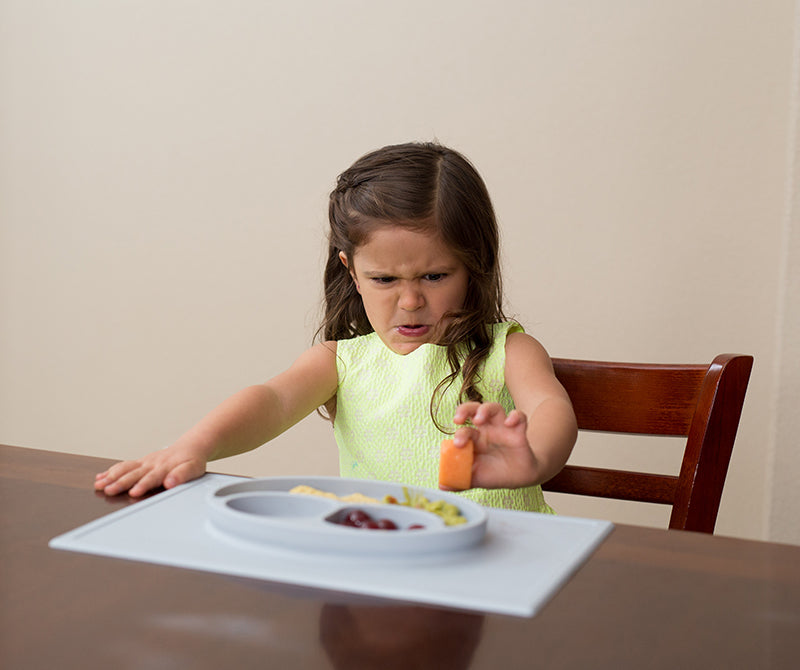Getting kids to eat the recommended daily amount of fruits and veggies can throw parents into a state of panic. For parents with finicky or picky eaters, this can be an ongoing emotional struggle. Here are some reasons why kids refuse fruit, as well as some strategies for parents and feeding therapists to help picky fruit eaters.
The Skin – Some fruits (e.g., apples, pears, plums, grapes and persimmons) have certain nutrients that are only found in the skin. In my experience, these are the top three reasons picky fruit eaters refuse to eat the skin.
Refusal 1: They can’t bite through or chew the skin. Biting and chewing are oral motor skills that may be challenging for some children to learn without practice and patience.
Parent Strategy: Help your child learn these important feeding milestones by modeling these skills. Make it fun and animatedly bite into fruit and over-exaggerate your rotary chewing pattern.
Refusal 2: They can taste the contaminants and/or pesticides. I have had several kids tell me in feeding therapy that they can taste dirt, wax and chemicals on fruit. Some children are super tasters and, believe it or not, can taste the difference between organic and regular fruit. As an example, if you have ever noticed that a cucumber has a sticky or waxy coating you can relate to these kids.
Parent Strategy: Consider trying organic produce for a period of time when you are introducing a new fruit. Also try washing fruit with a vegetable brush and vinegar (or another type of tasteless produce wash). For more clean-eating facts, feeding tips and a list of fruits to try with your kids check out our book: Making Mealtime ezpz.
Refusal 3: They demand to have the skin peeled or grated. Some children have sensory-based feeding issues and require removal of the skin in order to eat and enjoy certain fruits.
Parent Strategy: Consider offering fruits like red bell peppers and tomatoes, both of which have nutritious properties throughout the entire fruit, not just in the skin.
The Juice – Some children are unable to chew and swallow the multiple textures (the skin, flesh, seeds and juice) that some fruits contain. These kids can choke when trying to eat, and if they choke once, they may refuse to eat all types of fresh fruit.
Refusal 1: They can’t swallow liquid while holding solids in their mouth. Being able to stop chewing, hold food in your mouth and swallow liquid requires a combination of oral motor skills, and some children need to safely practice these skills in order to learn.
Parent Strategy: When teaching this skill, make sure to cut up very small pieces of fruit. I see kids trying to learn this skill with large pieces, and they can choke on either the liquids or the solids or a combination of both. Remember, the smaller the bite the better success they will have learning how to ‘stop, hold and swallow’ safely.
The Seeds – Eating or not eating seeds can be confusing for children learning about new fruits. In fact, seeds can be intimidating for parents, too, especially those who are looking to expand their child’s fruit repertoire and try more exotic fruits, like dragon fruit. Are dragon fruit seeds edible? If parents are not sure, they may not want to introduce this unique fruit. By the way, dragon fruit seeds ARE edible, just like the kiwi!
Refusal 1: They can taste the bitterness. Some kids have accidentally eaten an apple or lemon seed and have tasted the pungency of the seed. So, when we try to encourage them to eat a microscopic kiwi or a strawberry seed, feeding battles can begin.
Parent Strategy: Increase your child’s awareness of seeds in fruit; I call it Seed Education. Make a list of five fruits to try (e.g., cucumber, cherry tomatoes, grapes, oranges and mango) and write down whether the seeds can be eaten and how big the seeds are. Once you have had fun exploring the seeds in the five fruits, try another five!
Refusal 2: They are afraid they are going to choke on the seeds. Several of my pediatric clients have told me that they are fearful of choking on a seed. They are nervous about biting into an orange slice, as there could be a hidden seed and they may choke. These are the kids that will say they love fruit, but will only eat fruit smoothies and purees, because they can find seeds easily in those textures.
Parent Strategy: In my private practice, when kids don’t eat edible fruit seeds, we need to re-teach the above oral motor strategies of biting, chewing, holding food in their mouth, swallowing liquids and consuming multiple textures. We show and teach them that they can take a small bite of kiwi, chew the seeds, pulp, and juice and swallow safely. In addition, the above Seed Education is a great way to demonstrate that they are not going to choke on a mango or avocado seed (they are way too big!), so these are ‘safe fruits’ to eat. Hopefully they are willing to explore and eat more safe fruits!
I hope you have learned why fruit can oftentimes be a difficult food for children to eat and enjoy. Let us know which parent strategy was most successful in your home! What other techniques do you find helpful in getting your children to eat fruit? #ezpzfun #fruit #pickyeater



